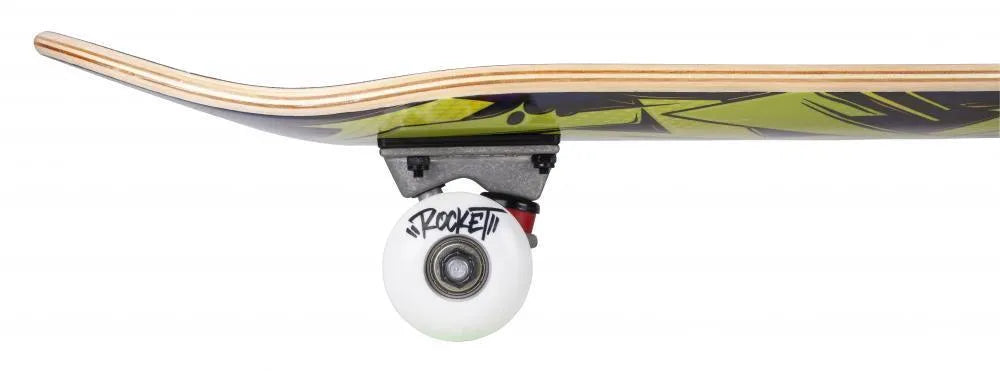Rocket Skateboards 29" Complete Skateboard Drips Mini 8"
Rocket Skateboards 29" Complete Skateboard Drips Mini 8"
Out of stock
Couldn't load pickup availability
Rocket Skateboards 29" Complete Skateboard Drips Mini 8"
Rocket skateboard completes come set-up ready to ride. With real concave and pop, these boards are perfect for beginner skaters looking for a quality entry level board.
Rocket boards are made by skaters, for skaters.
- Deck: 7 ply Hardrock Maple
- Trucks: 5’’ raw finish w/ Logo & 85a PU Cast cushion
- Wheels: 52mm x 30mm 92a
- Bearings: Abec 5
- Pre Assembled and ready to ride, perfect intermediate/starter skater with premium quality at a great price
Click here for our full range of Skateboard
Street-style skateboard
View our full skate range here
The street skateboard is all about tricks, speed, and creative movement through the urban environment.
It thrives in cities filled with rails, stairs, curbs, and ledges ready to be transformed into obstacles.
Skaters use public architecture to land tricks and express personal style through motion.
At the core of street skating is one specific design: the double kick tail skateboard.
This board features an upward curve on both ends, making it ideal for tricks.
With a double kick tail, skaters can perform tricks from either side with equal precision.
It’s built for flips, grinds, manuals, and fast directional changes—not just smooth cruising.
This skateboard isn't just for transportation. It’s a tool for technical expression, movement, and creativity.
Street skaters rely on their boards to react quickly and perform under tough urban conditions.
The anatomy of a double kick tail board
A street-style skateboard consists of several key parts that each play a vital role:
-
Deck: This is the flat wooden surface where skaters stand.
Most decks are made from seven layers of Canadian maple wood.
The wood is durable, flexible, and responsive to pressure during tricks. -
Grip tape: A sandpaper-like layer on top of the deck.
It helps skaters keep their feet planted while riding or performing tricks.
Without grip tape, balance and control would be extremely difficult. -
Trucks: These are T-shaped metal parts attached beneath the deck.
They hold the wheels and allow the board to turn.
Good trucks absorb shock and help with grinding on rails and ledges. -
Wheels: Usually made of hard urethane and built for speed.
Smaller, harder wheels are better for street skating and offer control on rough pavement. -
Bearings: Small circular components that fit inside the wheels.
They help the wheels spin freely and affect the board’s speed.
High-quality bearings make a huge difference in ride smoothness.
Double kick tail boards are also slightly concave. This inward curve gives riders better foot placement and control. The concave shape improves balance, flip tricks, and stability during landings.
The History of Skateboarding
Skateboarding began in the 1940s and 1950s in California. Surfers wanted something to ride when waves were flat. They attached roller-skate wheels to wooden boards. These early versions of the skateboard had metal wheels and no real control.
By the 1960s, companies started mass-producing skateboards. Clay wheels replaced metal ones, improving grip and control. Skateboarding gained popularity, with the first professional competitions emerging. However, safety concerns led to a decline by the late 1960s.
In the early 1970s, polyurethane wheels revolutionized skateboarding. These skateboard wheels provided better traction and smoother rides. Skateparks started appearing, offering dedicated spaces for skaters. The Zephyr team, also known as the Z-Boys, pushed skateboarding’s limits. They introduced aggressive, surf-inspired moves in empty pools.
The late 1970s saw the rise of vertical skateboarding. Skaters like Tony Alva and Stacy Peralta popularized aerial tricks. Skateboarding became more extreme, with bigger ramps and riskier moves. By the early 1980s, skateparks started closing due to liability issues.
Street skating grew in response to the lack of skateparks. Skaters adapted urban environments like curbs, rails, and stairs. Rodney Mullen pioneered technical tricks, including the kickflip and ollie. His innovations shaped modern street skating.
The 1990s saw skateboarding explode in mainstream culture. Video games, clothing brands, and skate magazines fueled its popularity. The X Games, launched in 1995, gave skaters a global platform. Tony Hawk became the face of skateboarding with his high-flying tricks.
By the 2000s, skateboarding was a billion-dollar industry. Skaters like Paul Rodriguez and Nyjah Huston emerged as stars. More cities built skateparks, recognizing skateboarding’s cultural significance. Skateboarding became an Olympic sport in 2021, proving its worldwide appeal.
Today, skateboarding continues to evolve with new tricks and styles. Social media allows skaters to showcase their skills globally. Skateboarding remains a creative and rebellious expression of individuality.
Share




FAQs
Got a question? We are here to answer






